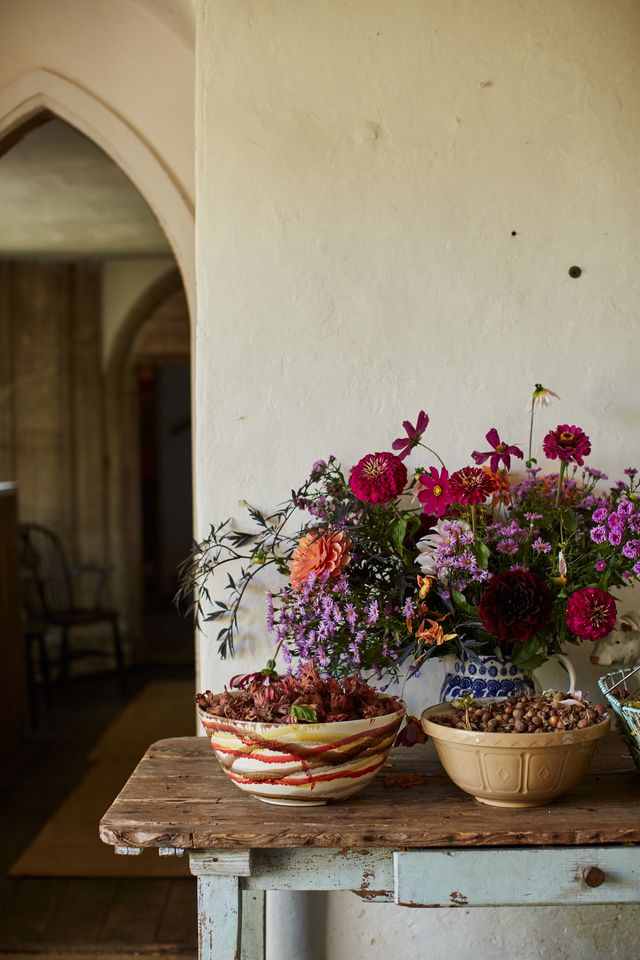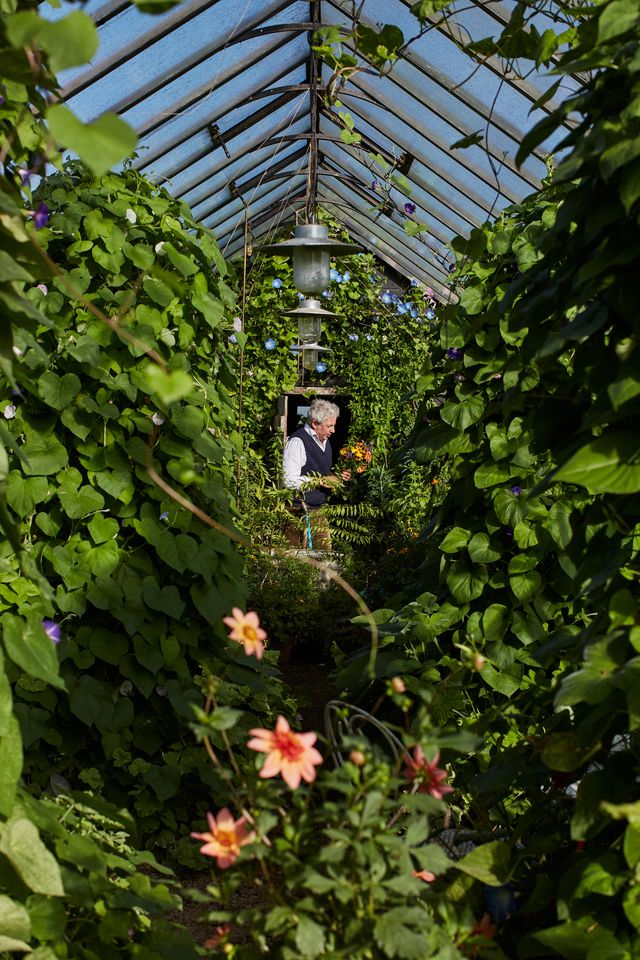The West Oxfordshire town of Bampton is a picturesque place with a number of well-kept period properties lining the streets. As you head towards Clanfield, there is a discrete turning into the driveway which takes you to the imposing Ham Court, owned by designer, illustrator and author Mattew Rice.
The grounds of the property are hidden by trees and native hedges and, as you slowly drive down the gravel driveway, you feel that you are going back in time through the centuries. Grazing flocks of sheep amble around the apple orchards and the only sounds to be heard are from the bells of the Medieval St Marys as they peel out on a Sunday morning.
 Once the site of Bampton Castle, a royal manor house thought to be given to the Earl of Pembroke William de Valence by Henry III and then fortified in 1315 by Valence’s son Aymer, the castle was demolished prior to the 18th century. Only the western gate house, carved from part of the original castle wall and gate passage, remained to be converted into the house now known as Ham Court. Although further extended in the 19th century, this fascinating and atmospheric property retains many Medieval features including large archways, vaulted ceilings from the original gate passage and an octagonal stair turret with battlemented parapet.
Once the site of Bampton Castle, a royal manor house thought to be given to the Earl of Pembroke William de Valence by Henry III and then fortified in 1315 by Valence’s son Aymer, the castle was demolished prior to the 18th century. Only the western gate house, carved from part of the original castle wall and gate passage, remained to be converted into the house now known as Ham Court. Although further extended in the 19th century, this fascinating and atmospheric property retains many Medieval features including large archways, vaulted ceilings from the original gate passage and an octagonal stair turret with battlemented parapet.
Jesus College had owned Ham Court for 145 years when they put the property, together with its paddocks and pasture land, a pair of Victorian semi-detached cottages, and several outbuildings up for sale in 2010. Matthew, and his former wife (the ceramicist and artist Emma Bridgewater), decided that it was the perfect place to renovate, turning the barns and gardens into a creative space which could be shared with others as part of their business enterprise.
When the couple moved in, both house and gardens were in desperate need of extensive renovation and lacked any reasonable form of modern facilities. With his fascination of old buildings and architecture, held since he was a teenager, Matthew was the perfect person to take on such a restoration project. Over the years, he has written and illustrated several books providing his readers with an incredible collection of architectural drawings about the history and language of buildings, both in the UK and in Italy, offering an insight into how these properties should be converted to help them harmonise with their surroundings.
Working with his former brother-in-law (a landscape designer) Matthew and Toti took a period of two years to complete the ground works required to establish a garden area on the four acres of ground inside the moat which surrounds part of the main house. Unsightly modern farm buildings were demolished, and the castle moat was reinstated. Some 11,000 trees and hedging plants were planted as whips around the boundaries of the land to create a screen of privacy from the main road and side boundaries. Now these trees and hedges have created the effect he intended as they provide a diverse range of planting around the property.
By building new walls around what is now the main kitchen garden, Matthew was able to create a sheltered space where a range of vegetables, fruit trees and flowers grow side by side throughout the year. There is also a large, quite contemporary-looking greenhouse which leads into an atmospheric wooden potting shed, with walls lined with the hand tools necessary to care for gardens of this size. A polytunnel, keeping its contents out of the way of marauding pigeons and hungry rabbits, is hidden by hawthorn hedging. Here, with a warmer temperature and no rain, the space offers the perfect location for a range of vegetables to be grown along with two peach trees. A second smaller kitchen garden, closer to the main drive, is bordered by hurdle fencing, keeping wildlife off the asparagus and potatoes which are planted there. Beyond the main part of gardens, there is a working farm with Berkshire pigs, Hereford Cattle and chickens. The organic waste produced from this smallholding has been vital in embellishing the shallow, free draining soil on which the property sits.
The old walls at the rear of the house are festooned with different climbing roses including Madame Gregoire Staechelin which produces a profusion of semi-double clusters of glowing pink, deliciously fragrant flowers in early summer. Close by is Rosa 'Cécile Brünner', a later-flowering climber with small, pale pink flowers which is repeat flowering. At the front entrance to the house, Matthew is creating a gravel garden with Verbascum, irises and euphorbia growing happily in the perfect soil conditions.
 Across the main entrance area, you will find Matthew’s studio, converted from an old Victorian barn with an establishing courtyard garden. Now a bright and airy space it comfortably holds up to 30 people for the regular art classes and workshops held throughout the year. The old barn is clearly the domain of a highly creative person; this is where Matthew works, creating his botanical and architectural illustrations used in his books and items for sale through his website. The room is wonderfully disorganised with numerous pottery samples from his 30-year long partnership with his ex-wife Emma, and tea towels created by his late mother Pat Albeck, a renowned textile designer.
Across the main entrance area, you will find Matthew’s studio, converted from an old Victorian barn with an establishing courtyard garden. Now a bright and airy space it comfortably holds up to 30 people for the regular art classes and workshops held throughout the year. The old barn is clearly the domain of a highly creative person; this is where Matthew works, creating his botanical and architectural illustrations used in his books and items for sale through his website. The room is wonderfully disorganised with numerous pottery samples from his 30-year long partnership with his ex-wife Emma, and tea towels created by his late mother Pat Albeck, a renowned textile designer.
Matthew is a watercolour artist who discovered the joy of painting in watercolour at the age of 14 when a friend of his godmother died and left him a ream of fine watercolour paper. Once he experienced the magical way the paints worked on quality paper, he continued to develop his skills as an artist. Not only was Matthew’s mother an artist but his father, Peter Rice, was an esteemed stage designer creating scenery and stage sets for a number of prestigious West End theatres including the Royal Opera House. As a consequence, it was inevitable that Matthew would pursue a career connected with the arts and he followed in his father’s footsteps studying painting and theatre design at Chelsea College of Art and Design.
 The garden which Matthew has created at Ham Court also provides much inspiration for his artwork. Amongst the favourite plants he grows, and paints, are Zinnias which he sows from seeds and plants as annuals each year. Painting in a loose but realistic style, Matthew’s botanical drawings from plants in his garden and surrounding farmland carefully capture the characteristics and colours, celebrating the essence of each plant and flower. Through the year, he holds one and two-day non-residential watercolour painting courses, where he shares his pleasure and techniques of painting with watercolour with the participating small groups of students.
The garden which Matthew has created at Ham Court also provides much inspiration for his artwork. Amongst the favourite plants he grows, and paints, are Zinnias which he sows from seeds and plants as annuals each year. Painting in a loose but realistic style, Matthew’s botanical drawings from plants in his garden and surrounding farmland carefully capture the characteristics and colours, celebrating the essence of each plant and flower. Through the year, he holds one and two-day non-residential watercolour painting courses, where he shares his pleasure and techniques of painting with watercolour with the participating small groups of students.
In addition to the various art classes held in the Studio, Ham Court also provides the perfect location for his daughter Lil and Dave Cross to run Fool’s Delight, a circus and dinner show for all ages. Lil’s aunt, Emma’s sister, was Nell Gifford, founder of Gloucestershire based Gifford’s Circus. When she sadly passed away in 2019 losing her fight against breast cancer, she entrusted her beloved circus to her niece. For nine days each April, Fool’s Delight puts on an eerie, turn-of-the-century foray into Spring with flower fairies and fairground folk, a mystic and magician. With a two-part family-friendly circus show held earlier in the day, the evening show is for an older audience and includes a three course dinner created by the exceptionally talented head chef Dave Cross. Another Circus event is planned for August. Later in the year in early September, Dave will create a sensational supper of seasonal produce, some of which will have been grown in the Kitchen Garden, as part of a Garden Supper and Private Viewing of the gardens at Ham Court, hosted by Matthew.
The gardens at Ham Court are open to the public on selected dates during the year and are certainly worth a visit. There will be an open day on 21 July from 10am until 5pm. Tickets are purchased on the day at the entrance gate. The gardens will also be open as part of the National Garden Scheme Open Gardens on 8 September from 2pm until 6.30pm for which tickets can be pre-booked by visiting findagarden.ngs.org.uk/garden/33900/ham-court.
To find out more about events at Ham Court, please visit matthewricewatercolours.co.uk
Images courtesy of Matthew Rice









